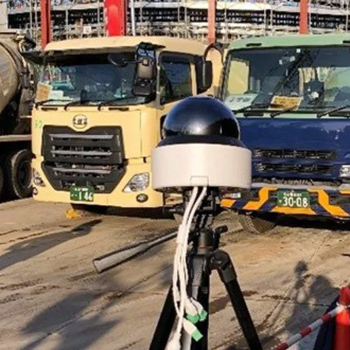The construction industry, known for its traditional practices, is undergoing a remarkable transformation fueled by the convergence of artificial intelligence (AI), big data, and edge computing technologies. This powerful combination is revolutionizing the way construction projects are planned, designed, and executed, leading to increased efficiency, productivity, safety, and sustainability. In this article, we will delve into the top 10 AI and big data technology trends that are reshaping the construction industry while also exploring the crucial role of edge computing in enabling these advancements.
The construction sector, historically reliant on manual processes and paper-based workflows, has embraced the digital era and emerged as a hotbed for technological innovation. AI and big data have become pivotal in optimizing construction operations, reducing costs, and improving project outcomes. Furthermore, the advent of edge computing, which brings computation and data storage closer to the source of data generation, has provided real-time capabilities and accelerated decision-making processes in the construction industry.
Now, let us introduce 10 innovative technologies that are transforming the construction industry:
1. Automated Project Planning
AI-powered algorithms are driving a significant shift in project planning within the construction industry. By leveraging historical data, project parameters, and resource availability, these algorithms optimize construction schedules, allocate resources efficiently, and identify potential bottlenecks. Automated project planning enables companies to complete projects on time and within budget, while also considering various constraints and uncertainties. The integration of edge computing plays a crucial role in this trend by enabling real-time data processing, allowing for dynamic adjustments to project plans and resource allocations as conditions change.
2. Predictive Maintenance
The combination of AI, big data, and edge computing is transforming maintenance practices in construction. Sensors installed on equipment and machinery collect real-time data on various parameters such as temperature, sound, vibration, and performance metrics. This data is then analyzed using AI algorithms and compared with historical data to identify patterns and anomalies. Predictive maintenance models can accurately predict potential failures or maintenance needs, enabling construction companies to take proactive measures before equipment breakdowns occur. By leveraging edge computing capabilities, this data analysis and prediction process can be performed in real-time, allowing for immediate actions to be taken to prevent costly downtime, extend equipment lifespan, and enhance overall project efficiency.
3. Safety Enhancement
AI technologies have tremendous potential to enhance safety practices within the construction industry. Computer vision systems equipped with AI algorithms – like Avinton’s Edge AI Camera – can monitor construction sites in real-time, identifying potential hazards such as unsafe worker behavior, unauthorized access, or equipment malfunctions. These systems can provide immediate alerts and warnings, allowing construction teams to take corrective actions promptly. Additionally, AI algorithms can analyze historical safety data to identify patterns and risk factors, enabling proactive measures to prevent accidents and improve overall safety performance. The integration of edge computing is crucial in this context, as it enables real-time data processing and analysis, ensuring immediate response and reducing potential risks.
4. Construction Material Optimization
Big data analytics, when combined with AI algorithms and edge computing, can optimize the selection and usage of construction materials. Construction companies generate vast amounts of data related to material properties, costs, availability, and environmental impact. By leveraging this data, AI algorithms can recommend the most suitable materials for specific projects based on criteria such as strength, durability, cost-effectiveness, and sustainability. Big data analytics enable comprehensive analysis of material-related data, facilitating informed decision-making. The integration of edge computing empowers real-time analysis of material data, enabling immediate adjustments to material selection and usage, reducing waste, and promoting sustainable construction practices.
5. Real-Time Monitoring
The integration of AI, big data, and edge computing allows for real-time monitoring of construction sites, providing valuable insights to project managers. AI-powered sensors, drones, and IoT devices collect and transmit data on construction progress, quality, safety compliance, and environmental conditions. This real-time monitoring enables project managers to identify potential issues, track progress, and make informed decisions promptly. The combination of big data analytics and AI algorithms allows for predictive analysis and forecasting, helping construction teams anticipate challenges and optimize resource allocation. The utilization of edge computing ensures that data processing and analysis occur at the site, minimizing latency and facilitating immediate actions.
6. Quality Control and Defect Detection
AI and big data analytics revolutionize quality control processes in construction projects. Computer vision systems equipped with AI algorithms can analyze images or videos of construction components in real-time, detecting defects, deviations from specifications (such as size or weight abnormalities), or construction errors. By automating the quality control process, construction companies can significantly reduce errors, improve productivity, and ensure higher quality standards. The integration of edge computing plays a critical role here, enabling on-site processing and immediate feedback, facilitating swift corrective measures, and minimizing rework.
7. Construction Equipment & Vehicle Tracking
AI and big data technologies enable construction companies to track and manage their equipment and vehicles effectively. IoT sensors and devices can provide real-time information on equipment locations, vehicle movements, usage patterns, performance metrics, and maintenance schedules. This data can be analyzed using AI algorithms to optimize equipment and vehicle utilization, identify potential issues, and enhance operational efficiency. Edge computing ensures that data processing and analysis occur locally, reducing latency and allowing for immediate actions such as maintenance scheduling, optimizing equipment deployment and vehicle traffic management at the construction site, and minimizing costs associated with equipment downtime.
8. Energy Efficiency
AI and big data analytics, complemented by edge computing, have a significant impact on energy efficiency within the construction industry. By analyzing energy usage patterns and building performance data, AI algorithms can identify areas of inefficiency and recommend energy-saving strategies. Real-time monitoring of energy consumption, enabled by edge computing, allows for immediate adjustments and optimizations, ensuring optimal energy usage and minimizing waste. Energy-efficient construction practices not only reduce operational costs but also contribute to the sustainable development goals (SDGs).
9. Enhanced Collaboration
AI-powered collaboration platforms are transforming stakeholder interactions during construction projects. These platforms facilitate real-time communication, document sharing, and project coordination among stakeholders, including architects, engineers, contractors, and clients. Enhanced collaboration improves productivity, reduces errors, and fosters better decision-making by providing instant access to project data, 3D models, design iterations, and project updates.
10. Augmented Reality (AR) in Design and Visualization
AR technology, enhanced by edge computing, is revolutionizing the design and visualization process in construction. Architects and engineers can utilize AR to overlay digital designs onto the physical environment, providing a realistic and immersive representation of the final project. AR enables stakeholders to visualize the project before construction begins, facilitating better communication, reducing design errors, and enhancing client engagement. The integration of edge computing ensures that the processing and rendering of AR models occur locally, allowing for real-time interaction and seamless user experiences.
Conclusion
The integration of AI, big data, and edge computing technologies is propelling a profound transformation within the construction industry. These advancements have ushered in a new era of efficiency, productivity, safety, and sustainability in construction projects. The 10 trends we have explored demonstrate the transformative impact of these technologies across various aspects of the construction lifecycle.
Automated project planning, predictive maintenance, safety enhancement, construction material optimization, real-time monitoring, quality control and defect detection, construction equipment tracking, energy efficiency, enhanced collaboration, and augmented reality in design and visualization all contribute to reshaping the construction industry for the better.
The seamless integration of AI, big data, and edge computing allows for real-time data processing, immediate actions, and enhanced decision-making capabilities. From optimizing project schedules and allocating resources efficiently to predicting and preventing equipment failures, these technologies are streamlining operations and improving project outcomes. Safety practices are being revolutionized through real-time monitoring and analysis, while sustainable practices are promoted through optimized material selection and energy-efficient strategies.
Moreover, the construction industry is experiencing enhanced collaboration among stakeholders, facilitated by AI-powered platforms and supported by edge computing capabilities. Stakeholders can communicate in real-time, share documents, and coordinate effectively, leading to increased productivity, reduced errors, and better decision-making.
As the construction industry continues to embrace these trends, we can anticipate even more profound advancements and synergies. The construction landscape of the future will be characterized by precision, safety, and sustainability, driven by AI and big data technologies.
It is essential for construction companies and professionals to adapt to these evolving technologies and harness their potential. By doing so, the industry can unlock new possibilities, drive innovation, and deliver projects that exceed expectations. Collaboration among industry stakeholders, technological pioneers, and regulatory bodies will be pivotal in shaping the future of the construction industry. We at Avinton consider ourselves strong and reliable partners for such undertakings. Our company has a proven track record of guiding industry leaders through their digital transformation processes, and we will be happy to discuss collaboration opportunities on an individual basis.
Together with our clients, we are seeing that the convergence of AI, big data, and edge computing is revolutionizing the construction industry, enabling enhanced efficiency, safety, sustainability, and collaboration. With ongoing advancements, the industry is poised to achieve new levels of excellence, transforming the way projects are planned, executed, and managed. The future of construction is undoubtedly bright as it embraces the power of these transformative technologies.

Our Edge AI Solutions in the Construction Industry
In 2023, the Japanese construction company Hazama Ando Corporation announced the development of an automated quantity and time management system for concrete placement using Avinton Japan’s Edge AI technology. By making full use of ICT tools for concrete placement, the company was able to realize labor savings and quality assurance.

Number Plate Recognition Model for Automated Vehicle Management
In the age of digital transformation, more and more companies are looking for ways to innovate their business processes. We have developed a machine-learning model that recognizes the license plates of Japanese vehicles with high accuracy. This AI model can be embedded in our Edge AI camera, which recognizes license plates in real-time. Automated number plate recognition (ANPR) is expected to automate and streamline manual and inspection tasks in construction site management, traffic volume surveys, and parking lot management.
Our client, a major general contracting company, was challenged by the extremely time-consuming management of mixer trucks and other construction vehicles. Working with the client, we have automated not only the detection of license plate information but also the management of vehicle arrival, unloading time, and departure time with an Edge AI camera equipped with the ANPR model.
AI, big data, and edge computing technologies are revolutionizing the construction industry, enabling greater efficiency, safety, sustainability, and collaboration. The construction industry is in a constant state of evolution, incorporating innovative approaches to project planning, execution, and management. We are convinced that the industry is moving toward a bright future by proactively embracing cutting-edge technologies.
Contact us
We will be happy to provide you with more information.







